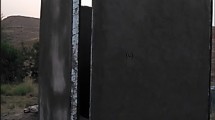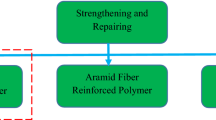Abstract
The Reactive Powder Concrete (RPC) is made of a very fine homogeneous and compact matrix, with short steel fibres. The material (matrix and fibres) is a composite and therefore heterogeneous. From this heterogeneity of the mechanical characteristics, elastic fields are influenced by the presence of fibres and are a function of the percentage of fibres as well as orientation of the fibrous reinforcement. During the preparation of the RPC the fibrous suspension is equivalent to a concentrated solution. The consequence is a local alignment of fibres, under effect of strong gradients of shearing, and a regrouping of fibres by cluster. The result is a particular configuration for the distribution from fibres within the structure. The purpose of this study is to model, with finite element method, the mechanical behaviour of RPC elements by taking into account internal heterogeneities. Ready-made structural elements (beams) have been tested under flexure. The comparison between numerical approach and experimental investigations confirms the role played by the internal heterogeneities on the mechanical behaviour before and after the initiation of cracking. Therefore, the results of this study can be used to understand how we can optimise the process of casting.
Résumé
Le béton de poudre réactive est constitué d'une matrice cimentaire compacte et homogène et de fibres métalliques courtes. Le matériau (composé d'une matrice et de fibres) est composite donc hétérogène. Compte tenu de cette hétérogénéité, les caractéristiques mécaniques comme les champs élastiques sont perturbés par la présence de fibres et sont fonction du pourcentage de fibres et de l'orientation du renforcement fibreux. Au moment de la fabrication du béton de poudre réactive, la suspension fibreuse est celle d'une solution concentrée en fibres. La conséquence est un alignement local des fibres sous l'effet de forts gradients de cisaillement et un regroupement des fibres en paquets. Il en résulte une configuration particulière pour la distribution des fibres à l'intérieure d'une structure. L'objectif de cette étude est de modéliser, en utilisant un code aux éléments finis, le comportement mécanique du béton de poudre réactive en prenant encompte les hétérogénéités internes. Des éléments de structure préfabriqués (des poutres) ont été testées en flexion. Les comparaisons effectuées entre une approche numérique et des résultats expérimentaux confirment le rôle joué par les hétérogénéités internes sur le comportement mécanique avant et après endommagement. De plus, les résultats de cette étude peuvent être utilisés pour comprendre comment il est possible d'optimiser le procédé de fabrication.
Similar content being viewed by others
References
Li, V.C. and Wu, H.C., ‘Conditions for pseudo strain-hardening in fibre reinforced brittle matrix composites’,J. Appl. Mech. Rev. 45 (8) (1992) 390–398.
Quemada, D., ‘Rhéologie phénoménologique des dispersions concentrées’, dans ‘Rheology of heterogeneous fluids’, 21ème Colloque Français de Rhéologie, Strasbourg, Sept. 1986 1–13.
Eshelby, J.D., ‘The determination of the elastic field of an ellipsoidal inclusion and related problems’,Porc. R. Soc. Lond. A241 (1957) 376–396.
Christensen, R.M., ‘Mechanics of Composite Materials’, 1st Edn. (John Wiley & Sons, New York, 1979).
Mura, T., ‘Micromechanics of defects in solids’, 1st Edn. (Martinus Nijhoff, the Hague, 1982).
Plé, O. and Bayard, O., ‘Preliminary study of multiscale analysis in fibre reinforced concrete’,Mater. Struct. 35 (2002) 279–284.
Mazars, J., ‘Application de la mécanique de l'endommagement au comportement non linéaire de la rupture du béton de structure’, Thèse d'état (Univ. Paris 6, Paris, 1984).
Bažant, ZP., ‘Microplan Model for Strain-Controlled Inelastic Behaviour’, In ‘Mechanics of engineering materials’ (John Wiley & Sons, New York, 1984) 45–59.
Bayard, O. and Plé, O., ‘Fracture mechanics of reactive powder concrete: material modelling and experimental investigations’,Engineering Fracture Mechanics 70 (2003) 839–851.
Cook, J. and Gordon, J.E., ‘A mechanism for the control of crack propagation in all brittle systems’,Proc. Roy. Soc. 282A (1964) 508–520.
Pinchin, D.J. and Tabor, D., ‘Interfacial contact pressure and frictional stress transfer in steel fibre cement’. In ‘Testing and Test Methods of Fibre Cement Composites’, Proceedings of an International Conference (RILEM Association, London, 1978) 337–344.
Majumdar, A.J., ‘Properties of fibre reinforced composites’, in ‘Fibre Reinforced Cement and Concrete’, Proceedings of an International Conference (RILEM Association, London, 1975) 279–313.
Mindlin, R.D. and Cheng, D.H., ‘Thermoelastic stress in the semi-infinite solid’,J. Appl. Phys. 21 (1950) 931–933.
Author information
Authors and Affiliations
Rights and permissions
About this article
Cite this article
Plé, O., Bayard, O. Preliminary modeling of internal heterogeneities in fibre reinforced concrete. Mat. Struct. 38, 359–366 (2005). https://doi.org/10.1007/BF02479302
Received:
Accepted:
Issue Date:
DOI: https://doi.org/10.1007/BF02479302




